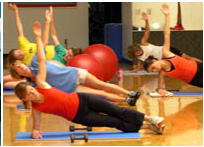
Numerous studies support the health benefits of spending time in nature. In my opinion, it makes much more sense to exercise in the expansive outdoors rather than being confined to small stationary spaces in gyms. Our bodies can adapt to a wide range of temperatures. Our ancestors spent almost all their waking hours working outside, irregardless of the season. Being active outside is an effective way to battle the "winter blues" that are often associated with cooler temps and shorter days. Fall is the perfect time to "play" in the fresh air.
Fall mornings can be chilly. To stay comfortable throughout your workout, dress in layers. It is important to be able to remove clothing as you heat up. Exercise generates an enormous amount of heat, making you feel up to 30 degrees warmer than the outdoor temperature. Your base layer should be made of sweat wicking material such as polypropylene, not cotton which remains wet on your skin. Many females prefer yoga pants or running tights in the colder months. Men often wear running tights underneath their athletic shorts. Fleece is a great second layer that provides light-weight insulation. On especially cold days, you may want to finish off with a breathable waterproof jacket.
During both exercise and cold temperatures, heat is drawn away from your extremities and directed towards your core and working muscles. Thirty to forty percent of heat is lost through your head so wear a warm headband or hat that covers your ears. Be sure to wear light-weight gloves that let your hands move. Finally, opt for thick socks. This might mean you need to wear a half shoe-size larger than usual to prevent your shoes from fitting too tight and interfering with foot circulation. People suffering from asthma can still withstand cooler temperatures by breathing into a scarf. The result is a naturally humid environment that can be easier on the airways than dry indoor air.
Be sure to hydrate! People tend to not feel "thirsty" in cooler weather. Remember, once you are "thirsty", you are already suffering from dehydration. You are still sweating in the cold; therefore, it is important to stay hydrated. Take a sip of water every 10-15 minutes during your workouts, whether you feel thirsty or not.
Finally, shorter days means you may need to work-out in the dark. Wear clothing with built in reflectors or wear a reflective running vest.
Don't let the chilly weather give you cabin fever. Remaining outdoors throughout the fall and winter is a great way to fight depression, the holiday bulge, and keep you mentally and physically healthy. The National Safety Council states it is perfectly safe to workout outside as long as the windchill is above -20 degree F. Get outdoors and enjoy!


